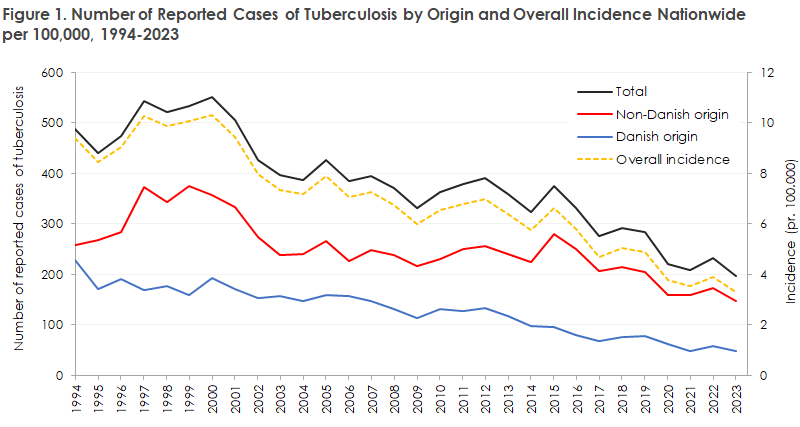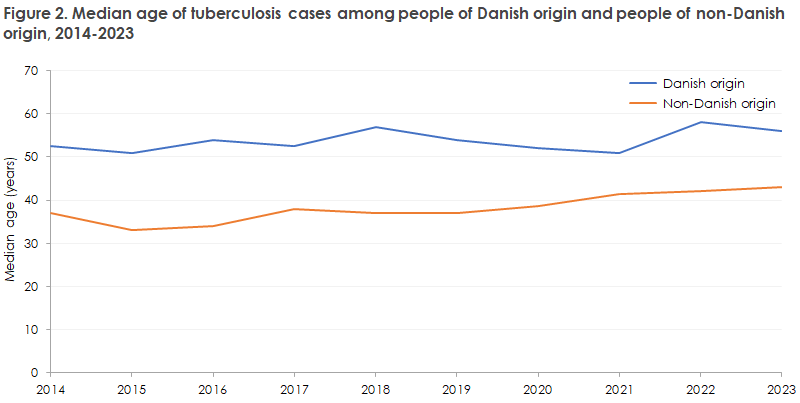No 50a - 2024
Tuberculosis in 2023
Tuberculosis in 2023
In 2023, 196 cases of tuberculosis (TB) were reported.

For a detailed epidemiological description of the occurrence in 2023, refer to Tuberculosis - report on disease occurrence in 2023.
In 2023, the overall incidence of TB nationwide was 3.3 cases per 100,000 inhabitants. As in previous years, the highest incidence was found in the Capital Region of Denmark (5.0 per 100,000), and highest in the Copenhagen City province (6.7 per 100,000), compared to other regions and provinces.
Trends in incidence
Since 2000, there has been a steady reduction in the number of new TB cases, with small fluctuations, from an incidence of 10.3 per 100,000 in 2000 to 3.3 in 2023. This corresponds to an annual reduction of 0.3 cases per 100,000 during the period. There was concern that the incidence of TB would increase after the COVID-19 pandemic, but although there was an increase in 2022, there has been a further decline in 2023, indicating that the COVID-19 pandemic has not changed the overall declining incidence of TB in Denmark since 2000, as shown in Figure 1.
The Capital Region of Denmark continues to have the highest incidence (5.0 per 100,000) and Region Zealand the lowest (1.3 per 100,000), as shown in Table 1. Since 2000, there has been a slight decrease in incidence in the Regions of Southern Denmark and Central Jutland, while the incidence has remained stable in Region Zealand and Northern Jutland, but has been slightly increasing in the Capital Region of Denmark.
Median age of cases
Among people of Danish origin with TB, the median age was 56 years, which is almost unchanged compared to 2022 (58 years). For people of non-Danish origin, it was 43 years, which is unchanged from previous years. There is thus still a significant difference in the age profile of TB cases between the two groups, with the highest incidence among people of Danish origin in the age group 50-69 years, while the highest incidence among people of non-Danish origin was in the age group 20-49 years. This difference has remained unchanged over the past 10 years.

Suspected country of infection
Based on information in the clinical reports, 78 (40%) people were suspected to have been infected in Denmark and 113 (58%) abroad. For the remaining cases, there was no information on the suspected country of infection. Overall, the numbers suggest an unchanged distribution between those infected in Denmark and abroad over the past 10 years. The fact that 40% are infected in Denmark and that this proportion has remained unchanged over the past 10 years shows that there is still a great need to trace and break chains of infection in Denmark.
Type of tuberculosis
Pulmonary TB continues to be the most common presentation for both people of Danish origin and people of non-Danish origin, with proportions of 79% and 68%, respectively. It is noted that the proportion of people of Danish origin with TB outside the lungs (extrapulmonary TB) has increased from 2017 (14%) to 2023 (21%). In 2023, only one case of TB meningitis was reported, while there were no other cases of TB in the central nervous system.
Microscopy positivity
The proportion of people with microscopy-positive pulmonary TB, where TB bacteria can be detected in sputum by microscopy, has decreased significantly in 2023 compared to the past few years, and the proportion is now almost back to the level before the COVID-19 pandemic. Microscopy positivity is a marker for disease burden and infectiousness. A rapid TB diagnosis thus reduces the risk of microscopy positivity. The decrease in microscopy positivity in 2023 may be due to resumed and increased screening activity among those in high-risk environments after the COVID-19 pandemic. Less disease burden reduces the number of complications for the individual patient and decreases the spread of infection in the community.
Tuberculosis among children
In 2023, 12 TB cases were reported among children under 18 years (16 in 2021, 8 in 2022). Half of the children were born in Denmark. Five of the six Danish-born children were suspected to have been infected in Denmark, while information on the suspected country of infection was missing for the last child. Among the six foreign-born children, the majority were suspected to have been infected abroad in Afghanistan, Bangladesh, Eritrea, and Turkey. One of the foreign-born children was suspected to have been infected in Denmark. Danish-born children had more frequent pulmonary TB compared to the foreign-born, who more frequently had extrapulmonary TB. Although the number of children and young people reported with TB remains low and declining, half of the reported cases in 2023 were infected in Denmark. This means that there should still be attention to contact tracing in Denmark.
HIV among TB cases
Out of the 196 TB cases in 2023, seven people were HIV-positive. Of the seven HIV-positive, three were newly diagnosed and four were known HIV-positive. 132 people were HIV-negative. For the remaining 57 people, HIV status was not indicated in the report. Since HIV is a significant risk factor for TB disease, it is crucial to test for HIV at the same time as the TB diagnosis is made, unless the patient is already known to be HIV-positive.
Tuberculosis among migrants from Ukraine
There has been significant international attention on TB among migrants from Ukraine due to the high prevalence in the country. In 2023, only three cases of TB were reported among migrants from Ukraine in Denmark, which was the same number as in 2022, including one MDR-TB case (resistance to isoniazid and rifampicin).
In general, there should continue to be special attention to risk factors for TB among migrants from Ukraine and from other countries with a high prevalence of TB. Tuberculosis should especially be considered in cases of:
- TB-compatible symptoms, primarily cough, bloody sputum, fever, weight loss, and/or night sweats, or
- Known close contact with a person infected with TB, or
- Known previous TB infection
Summary
Since 2000, there has been a significant general reduction in the number of new TB cases from an incidence of 10.3 per 100,000 in 2000 to 3.3 in 2023. However, there is still an extraordinarily high prevalence of TB in certain risk groups in Denmark, including people from areas of the world with a high prevalence of TB and among socially vulnerable population groups.
There have been no decisive changes over time in the general distribution of TB cases in terms of gender, age, origin, and TB type (pulmonary vs. extrapulmonary TB).
Although the frequency of TB continues to decline, it is important to maintain attention to TB in Denmark, both in terms of screening in risk groups, diagnosis, contact tracing, prevention, and reporting of the disease, especially in cases diagnosed based on clinical criteria alone.
(L.H. Holm, A. Koch, Department of Infectious Disease Epidemiology and Prevention, T. Lillebæk, D.B. Folkvardsen, Department of Tuberculosis and Mycobacteria)